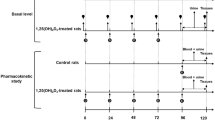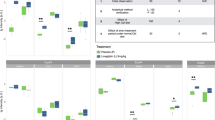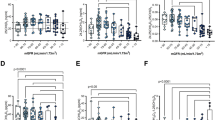Abstract
Purpose
This study investigated effects of 1α,25-dihydroxyvitamin D3 [1,25(OH)2D3] on biodistribution and pharmacokinetics of L-carnitine and creatinine as organic cation/carnitine transporter 2 (OCTN2) and organic cation transporter 2 (OCT2) biomarkers, respectively, together with mRNA expressional changes.
Methods
After four consecutive days of pretreatment with 1,25(OH)2D3 (2.56 nmol/kg/day), plasma, urine, and tissues were collected for analysis of endogenous L-carnitine and creatinine basal levels, or rats were intravenously administered exogenous L-carnitine (50 mg/kg). The selected tissues were subjected to analysis of rOCTN2 and rOCT2 gene expression using real-time quantitative polymerase chain reaction. The quantification of L-carnitine and creatinine was performed with liquid chromatography-tandem mass spectrometry.
Results
1,25(OH)2D3-treated rats exhibited decreased rOCTN2 mRNA expression in the liver, kidney, spleen, and brain, and decreased rOCT2 mRNA expression in the kidney. L-carnitine levels indicated that basal plasma abundance in the 1,25(OH)2D3-treated group elevated, whereas the tissue-plasma partition coefficient dropped in all tissues and the urine level also reduced. Exogenous L-carnitine pharmacokinetics were consistent with the endogenous level, with a significant rise in area under the curve and significant decreases in renal clearance and volume of distribution at steady state in the group treated with 1,25(OH)2D3. Additionally, the significant increase in plasma levels and decrease in renal clearance of creatinine were likely due to decreased OCT2 function.
Conclusion
Our observations suggest the risk of co-administering 1,25(OH)2D3 with OCT2 and/or OCTN2 substrates. Moreover, this study confirmed that L-carnitine and creatinine are sensitive endogenous biomarkers of OCTN2- and OCT2-mediated drug-drug interactions, respectively.





Similar content being viewed by others
References
Agarwal R, Hynson JE, Hecht TJ, Light RP, Sinha AD (2011) Short-term vitamin D receptor activation increases serum creatinine due to increased production with no effect on the glomerular filtration rate. Kidney Int 80:1073–1079
Balla A, Jeong YS, Kim HJ, Lee YJ, Chung SJ, Chae YJ, Maeng HJ (2021) Effects of 1α,25-dihydroxyvitamin D(3) on the pharmacokinetics of procainamide and its metabolite N-acetylprocainamide, organic cation transporter substrates, in rats with PBPK modeling approach. Pharmaceutics 13:1133
Bertoli M, Luisetto G, Ruffatti A, Urso M, Romagnoli G (1990) Renal function during calcitriol therapy in chronic renal failure. Clin Nephrol 33:98–102
Brooks DE, Mcintosh JE (1975) Turnover of carnitine by rat tissues. Biochem J 148:439–445
Brożyna AA, Jochymski C, Janjetovic Z, Jóźwicki W, Tuckey RC, Slominski AT (2014) CYP24A1 expression inversely correlates with Melanoma progression: clinic-pathological studies. Int J Mol Sci 15:19000–19017
Celestino-Soper PB, Violante S, Crawford EL, Luo R, Lionel AC, Delaby E, Cai G, Sadikovic B, Lee K, Lo C, Gao K, Person RE, Moss TJ, German JR, Huang N, Shinawi M, Treadwell-Deering D, Szatmari P, Roberts W, Fernandez B, Schroer RJ, Stevenson RE, Buxbaum JD, Betancur C, Scherer SW, Sanders SJ, Geschwind DH, Sutcliffe JS, Hurles ME, Wanders RJ, Shaw CA, Leal SM, Cook EH Jr, Goin-Kochel RP, Vaz FM, Beaudet AL (2012) A common X-linked inborn error of carnitine biosynthesis may be a risk factor for nondysmorphic autism. Proc Natl Acad Sci USA 109:7974–7981
Choi MS, Kim YC, Maeng HJ (2020) Therapeutic targets of vitamin D receptor ligands and their pharmacokinetic effects by modulation of transporters and metabolic enzymes. J Pharm Invest 50:1–16
Chu X, Bleasby K, Chan GH, Nunes I, Evers R (2016) The complexities of interpreting reversible elevated serum creatinine levels in drug development: does a correlation with inhibition of renal transporters exist? Drug Metab Dispos 44:1498–1509
Chu X, Chan GH, Evers R (2017) Identification of endogenous biomarkers to predict the propensity of drug candidates to cause hepatic or renal transporter-mediated drug-drug interactions. J Pharm Sci 106:2357–2367
Chu X, Liao M, Shen H, Yoshida K, Zur AA, Arya V, Galetin A, Giacomini KM, Hanna I, Kusuhara H, Lai Y, Rodrigues D, Sugiyama Y, Zamek-Gliszczynski MJ, Zhang L (2018) Clinical probes and endogenous biomarkers as substrates for transporter drug-drug interaction evaluation: perspectives from the international transporter consortium. Clin Pharmacol Ther 104:836–864
Czuba LC, Hillgren KM, Swaan PW (2018) Post-translational modifications of transporters. Pharmacol Ther 192:88–99
Deguchi T, Takemoto M, Uehara N, Lindup WE, Suenaga A, Otagiri M (2005) Renal clearance of endogenous hippurate correlates with expression levels of renal organic anion transporters in uremic rats. J Pharmacol Exp Ther 314:932–938
Dinarvand N, Karimi F, Azizi R, Rastaghi S, Sheikhi A, Pourfarzam M (2023) Evaluation of the gene encoding carnitine transporter (OCTN2/SLC22A5) expression in human Breast cancer and its association with clinicopathological characteristics. Mol Biol Rep 50:2061–2066
Ding S, Schoenmakers I, Jones K, Koulman A, Prentice A, Volmer DA (2010) Quantitative determination of vitamin D metabolites in plasma using UHPLC-MS/MS. Anal Bioanal Chem 398:779–789
Doan TNK, Vo DK, Kim H, Balla A, Lee Y, Yoon IS, Maeng HJ (2020) Differential effects of 1α,25-Dihydroxyvitamin D(3) on the expressions and functions of hepatic CYP and UGT enzymes and its pharmacokinetic consequences in vivo. Pharmaceutics 12:1129
Elsby R, Atkinson H, Butler P, Riley RJ (2022) Studying the right transporter at the right time: an in vitro strategy for assessing drug-drug interaction risk during drug discovery and development. Expert Opin Drug Metab Toxicol 18:619–655
Evans AM, Fornasini G (2003) Pharmacokinetics of L-carnitine. Clin Pharmacokinet 42:941–967
Fu X, Dolnikowski GG, Patterson WB, Dawson-Hughes B, Zheng T, Morris MC, Holland TM, Booth SL (2019) Determination of vitamin D and its metabolites in human brain using an Ultra-pressure LC-Tandem Mass Spectra Method. Curr Dev Nutr 3:nzz074
Giacomini KM, Huang SM (2013) Transporters in drug development and clinical pharmacology. Clin Pharmacol Ther 94:3–9
Goa KL, Brogden RN (1987) l-Carnitine. A preliminary review of its pharmacokinetics, and its therapeutic use in ischaemic cardiac disease and primary and secondary carnitine deficiencies in relationship to its role in fatty acid metabolism. Drugs 34:1–24
Gui B, Chen Q, Hu C, Zhu C, He G (2017) Effects of calcitriol (1, 25-dihydroxy-vitamin D3) on the inflammatory response induced by H9N2 influenza virus infection in human lung A549 epithelial cells and in mice. Virol J 14:10
Guillot X, Semerano L, Saidenberg-Kermanac’h N, Falgarone G, Boissier MC (2010) Vitamin D and inflammation. Joint Bone Spine 77:552–557
Haussler MR, Whitfield GK, Haussler CA, Hsieh JC, Thompson PD, Selznick SH, Dominguez CE, Jurutka PW (1998) The nuclear vitamin D receptor: biological and molecular regulatory properties revealed. J Bone Miner Res 13:325–349
Hedman CJ, Wiebe DA, Dey S, Plath J, Kemnitz JW, Ziegler TE (2014) Development of a sensitive LC/MS/MS method for vitamin D metabolites: 1,25 Dihydroxyvitamin D2&3 measurement using a novel derivatization agent. J Chromatogr B Analyt Technol Biomed Life Sci 953–954:62–67
Hurst EA, Homer NZ, Mellanby RJ (2020) Vitamin D metabolism and profiling in veterinary species. Metabolites 10:371
Imamura Y, Murayama N, Okudaira N, Kurihara A, Okazaki O, Izumi T, Inoue K, Yuasa H, Kusuhara H, Sugiyama Y (2011) Prediction of fluoroquinolone-induced elevation in serum creatinine levels: a case of drug-endogenous substance interaction involving the inhibition of renal secretion. Clin Pharmacol Ther 89:81–88
Iwata D, Kato Y, Wakayama T, Sai Y, Kubo Y, Iseki S, Tsuji A (2008) Involvement of carnitine/organic cation transporter OCTN2 (SLC22A5) in distribution of its substrate carnitine to the heart. Drug Metab Pharmacokinet 23:207–215
Jacobsson L (1983) A method for the calculation of renal clearance based on a single plasma sample. Clin Physiol 3:297–305
Jernberg JN, Bowman CE, Wolfgang MJ, Scafidi S (2017) Developmental regulation and localization of carnitine palmitoyltransferases (CPTs) in rat brain. J Neurochem 142:407–419
Jin HE, Kim IB, Kim CK, Maeng HJ (2013) Determination of cefdinir levels in rat plasma and urine by high-performance liquid chromatography-tandem mass spectrometry: application to pharmacokinetics after oral and intravenous administration of cefdinir. Biomed Chromatogr 27:1423–1430
Jones G (2008) Pharmacokinetics of vitamin D toxicity. Am J Clin Nutr 88:582s–586s
Jong NN, Nakanishi T, Liu JJ, Tamai I, Mckeage MJ (2011) Oxaliplatin transport mediated by organic cation/carnitine transporters OCTN1 and OCTN2 in overexpressing human embryonic kidney 293 cells and rat dorsal root ganglion neurons. J Pharmacol Exp Ther 338:537–547
Kato Y, Sugiura M, Sugiura T, Wakayama T, Kubo Y, Kobayashi D, Sai Y, Tamai I, Iseki S, Tsuji A (2006) Organic cation/carnitine transporter OCTN2 (Slc22a5) is responsible for carnitine transport across apical membranes of small intestinal epithelial cells in mouse. Mol Pharmacol 70:829–837
Katz R (2004) Biomarkers and surrogate markers: an FDA perspective. NeuroRx 1:189–195
Kido Y, Tamai I, Ohnari A, Sai Y, Kagami T, Nezu J, Nikaido H, Hashimoto N, Asano M, Tsuji A (2001) Functional relevance of carnitine transporter OCTN2 to brain distribution of L-carnitine and acetyl-L-carnitine across the blood-brain barrier. J Neurochem 79:959–969
Kim YC, Kim IB, Noh CK, Quach HP, Yoon IS, Chow ECY, Kim M, Jin HE, Cho KH, Chung SJ, Pang KS, Maeng HJ (2014) Effects of 1α,25-dihydroxyvitamin D3, the natural vitamin D receptor ligand, on the pharmacokinetics of cefdinir and cefadroxil, organic anion transporter substrates, in rat. J Pharm Sci 103:3793–3805
Kimura N, Okuda M, Inui K (2005) Metformin transport by renal basolateral organic cation transporter hOCT2. Pharm Res 22:255–259
Koepsell H, Endou H (2004) The SLC22 drug transporter family. Pflugers Arch 447:666–676
Kuwajima M, Lu K, Sei M, Ono A, Hayashi M, Ishiguro K, Ozaki K, Hotta K, Okita K, Murakami T, Miyagawa J, Narama I, Nikaido H, Hayakawa J, Nakajima H, Namba M, Hanafusa T, Matsuzawa Y, Shima K (1998) Characteristics of cardiac hypertrophy in the juvenile visceral steatosis mouse with systemic carnitine deficiency. J Mol Cell Cardiol 30:773–781
Lamhonwah AM, Barić I, Lamhonwah J, Grubić M, Tein I (2018) Attention deficit/hyperactivity disorder as an associated feature in OCTN2 deficiency with novel deletion (p.T440-Y449). Clin Case Rep 6:585–591
Lancaster CS, Hu C, Franke RM, Filipski KK, Orwick SJ, Chen Z, Zuo Z, Loos WJ, Sparreboom A (2010) Cisplatin-induced downregulation of OCTN2 affects carnitine wasting. Clin Cancer Res 16:4789–4799
Le QD, Duong VA, Lee SH, Maeng HJ (2023) Bioanalytical method validation, biopharmaceutical and pharmacokinetic evaluation of GSK-650394, a serum-and glucocorticoid-regulated kinase 1 inhibitor. Arab J Chem 16:104462
Lee SG, Cho KH, Nguyen TT, Vo DK, Chae YJ, Maeng HJ (2022) Inhibitory effect of 20(S)-protopanaxadiol on cytochrome P450: potential of its pharmacokinetic interactions in vivo. Biomed Pharmacother 153:113514
Lee SJ, Joo SA, Kim H, Lee Y, Chung SJ, Chae YJ, Maeng HJ (2023) Involvement of CYP3A4 and MDR1 in altered metabolism and transport of indinavir in 1,25(OH)(2)D(3)-treated Caco-2 cells. Eur J Pharm Sci 183:106396
Li Y, Talebi Z, Chen X, Sparreboom A, Hu S (2021) Endogenous biomarkers for SLC transporter-mediated drug-drug Interaction evaluation. Molecules 26:10
Lin L, Yee SW, Kim RB, Giacomini KM (2015) SLC transporters as therapeutic targets: emerging opportunities. Nat Rev Drug Discov 14:543–560
Longo N, Di Amat C, Pasquali M (2006) Disorders of carnitine transport and the carnitine cycle. Am J Med Genet C Semin Med Genet 142c:77–85
Lysne V, Bjørndal B, Vik R, Nordrehaug JE, Skorve J, Nygård O, Berge RK (2015) A protein extract from Chicken reduces plasma homocysteine in rats. Nutrients 7:4498–4511
Maeng HJ, Durk MR, Chow EC, Ghoneim R, Pang KS (2011) 1α,25-dihydroxyvitamin D3 on intestinal transporter function: studies with the rat everted intestinal sac. Biopharm Drug Dispos 32:112–125
Maeng HJ, Doan TNK, Yoon IS (2019) Differential regulation of intestinal and hepatic CYP3A by 1α,25-dihydroxyvitamin D(3): effects on in vivo oral absorption and disposition of buspirone in rats. Drug Dev Res 80:333–342
Mccann MR, De La Rosa G, Rosania MVGR, Stringer KA (2021) L-Carnitine and Acylcarnitines: Mitochondrial Biomarkers for Precision Medicine. Metabolites 11:1
Minematsu T, Giacomini KM (2011) Interactions of tyrosine kinase inhibitors with organic cation transporters and multidrug and toxic compound extrusion proteins. Mol Cancer Ther 10:531–539
Miyagawa J, Kuwajima M, Hanafusa T, Ozaki K, Fujimura H, Ono A, Uenaka R, Narama I, Oue T, Yamamoto K et al (1995) Mitochondrial abnormalities of muscle tissue in mice with juvenile visceral steatosis associated with systemic carnitine deficiency. Virchows Arch 426:271–279
Mochizuki T, Mizuno T, Maeda K, Kusuhara H (2021) Current progress in identifying endogenous biomarker candidates for drug transporter phenotyping and their potential application to drug development. Drug Metab Pharmacokinet 37:100358
Motohashi H, Inui K (2013) Organic cation transporter OCTs (SLC22) and MATEs (SLC47) in the human kidney. AAPS J 15:581–588
Müller F, Sharma A, König J, Fromm MF (2018) Biomarkers for in vivo assessment of transporter function. Pharmacol Rev 70:246–277
Nguyen TT, Duong VA, Vo DK, Jo J, Maeng HJ (2021) Development and validation of a bioanalytical LC-MS/MS method for simultaneous determination of Sirolimus in Porcine whole blood and lung tissue and pharmacokinetic application with coronary stents. Molecules 26:1
Okuda M, Saito H, Urakami Y, Takano M, Inui K (1996) cDNA cloning and functional expression of a novel rat kidney organic cation transporter, OCT2. Biochem Biophys Res Commun 224:500–507
Pauly DF, Pepine CJ (2003) The role of carnitine in myocardial dysfunction. Am J Kidney Dis 41:S35-43
Pearson DJ, Tubbs PK (1967) Carnitine and derivatives in rat tissues. Biochem J 105:953–963
Rebouche CJ (2004) Kinetics, pharmacokinetics, and regulation of L-carnitine and acetyl-L-carnitine metabolism. Ann N Y Acad Sci 1033:30–41
Rebouche CJ, Engel AG (1984) Kinetic compartmental analysis of carnitine metabolism in the human carnitine deficiency syndromes. Evidence for alterations in tissue carnitine transport. J Clin Invest 73:857–867
Rebouche CJ, Lombard KA, Chenard CA (1993) Renal adaptation to dietary carnitine in humans. Am J Clin Nutr 58:660–665
Robien K, Oppeneer SJ, Kelly JA, Hamilton-Reeves JM (2013) Drug-vitamin D interactions: a systematic review of the literature. Nutr Clin Pract 28:194–208
Schoindre Y, Terrier B, Kahn JE, Saadoun D, Souberbielle JC, Benveniste O, Amoura Z, Piette JC, Cacoub P, Costedoat-Chalumeau N (2012) Vitamin D and autoimmunity. First part: fundamental aspects. Rev Med Interne 33:80–86
Shepard RM, Deluca HF (1980) Plasma concentrations of vitamin D3 and its metabolites in the rat as influenced by vitamin D3 or 25-hydroxyvitamin D3 intakes. Arch Biochem Biophys 202:43–53
Slitt AL, Cherrington NJ, Hartley DP, Leazer TM, Klaassen CD (2002) Tissue distribution and renal developmental changes in rat organic cation transporter mRNA levels. Drug Metab Dispos 30:212–219
Taieb J, Prager GW, Melisi D, Westphalen CB, D’esquermes N, Ferreras A, Carrato A, Macarulla T (2020) First-line and second-line treatment of patients with metastatic pancreatic adenocarcinoma in routine clinical practice across Europe: a retrospective, observational chart review study. ESMO Open 5:1
Tamai I, Ohashi R, Nezu J, Yabuuchi H, Oku A, Shimane M, Sai Y, Tsuji A (1998) Molecular and functional identification of sodium ion-dependent, high affinity human carnitine transporter OCTN2. J Biol Chem 273:20378–20382
Tang NL, Ganapathy V, Wu X, Hui J, Seth P, Yuen PM, Wanders RJ, Fok TF, Hjelm NM (1999) Mutations of OCTN2, an organic cation/carnitine transporter, lead to deficient cellular carnitine uptake in primary carnitine deficiency. Hum Mol Genet 8:655–660
Thorpe JB, Rajabi N, Decatanzaro D (2012) Circadian rhythm and response to an acute stressor of urinary corticosterone, testosterone, and creatinine in adult male mice. Horm Metab Res 44:429–435
Türk D, Müller F, Fromm MF, Selzer D, Dallmann R, Lehr T (2022) Renal transporter-mediated drug-biomarker interactions of the endogenous substrates creatinine and N(1)-methylnicotinamide: a PBPK modeling approach. Clin Pharmacol Ther 112:687–698
Urakami Y, Kimura N, Okuda M, Inui K (2004) Creatinine transport by basolateral organic cation transporter hOCT2 in the human kidney. Pharm Res 21:976–981
US-FDA (2020) In vitro drug interaction studies-cytochrome P450 enzyme and transporter mediated drug interactions. FDA Guidline 1:1
Vo DK, Nguyen TT, Maeng HJ (2022) Effects of 1α,25-dihydroxyvitamin D(3) on the pharmacokinetics and biodistribution of ergothioneine, an endogenous organic cation/carnitine transporter 1 substrate, in rats. J Pharm Investig 52:341–351
Volpe DA (2016) Transporter assays as useful in vitro tools in drug discovery and development. Expert Opin Drug Discov 11:91–103
Walter JH (1996) L-carnitine. Arch Dis Child 74:475–478
Wang Y, Zhu J, Deluca HF (2012) Where is the vitamin D receptor? Arch Biochem Biophys 523:123–133
Weir MR (2011) Short-term effects of vitamin D receptor activation on serum creatinine, creatinine generation, and glomerular filtration. Kidney Int 80:1016–1017
Wyss M, Kaddurah-Daouk R (2000) Creatine and creatinine metabolism. Physiol Rev 80:1107–1213
Yoon IS, Son JH, Kim SB, Choi MK, Maeng HJ (2015) Effects Of 1α,25-dihydroxyvitamin D3 on intestinal absorption and disposition of adefovir dipivoxil and its metabolite, adefovir, in rats. Biol Pharm Bull 38:1732–1737
Yoon JH, Nguyen TT, Duong VA, Chun KH, Maeng HJ (2020) Determination of Kd025 (Slx-2119), a selective Rock2 inhibitor, in rat plasma by high-performance liquid chromatography-tandem mass spectrometry and its pharmacokinetic application. Molecules 25:1369
York CM, Cantrell CR, Borum PR (1983) Cardiac carnitine deficiency and altered carnitine transport in cardiomyopathic hamsters. Arch Biochem Biophys 221:526–533
Zhao Y, Liu G, Angeles A, Christopher LJ, Wang Z, Arnold ME, Shen JX (2016) A validated LC-MS/MS method for the quantitative measurement of creatinine as an endogenous biomarker in human plasma. Bioanalysis 8:1997–2005
Zhou T, Zhang Z, Luo F, Zhao Y, Hou X, Liu T, Wang K, Zhao H, Huang Y, Zhang L (2020) Comparison of First-Line treatments for patients with extensive-stage small cell Lung Cancer: a systematic review and network Meta-analysis. JAMA Netw Open 3:e2015748
Acknowledgements
This work was supported by the Gachon University Research Fund of 2020 (GCU- 202008420005) and the Basic Science Research Program through the National Research Foundation of Korea (NRF) funded by the Ministry of Science, ICT & Future Planning (NRF-2021R1F1A1060378).
Author information
Authors and Affiliations
Corresponding authors
Ethics declarations
Conflict of interest
All authors (D.-K. Vo, T.-T.-L. Nguyen, and H.-J. Maeng) declare that they have no conflict of interest.
Research involving in human and animal participants
The animal investigations were conducted after receiving approval of the Institutional Animal Care and Use Committee in Gachon University (approval No. GIACUC-R2019020, July 1st, 2019).
Additional information
Publisher’s Note
Springer Nature remains neutral with regard to jurisdictional claims in published maps and institutional affiliations.
Electronic supplementary material
Below is the link to the electronic supplementary material.
Rights and permissions
Springer Nature or its licensor (e.g. a society or other partner) holds exclusive rights to this article under a publishing agreement with the author(s) or other rightsholder(s); author self-archiving of the accepted manuscript version of this article is solely governed by the terms of such publishing agreement and applicable law.
About this article
Cite this article
Vo, DK., Nguyen, TTL. & Maeng, HJ. Impact of 1α,25-dihydroxyvitamin D3 on biodistribution and pharmacokinetics of L-carnitine and creatinine, organic cation/carnitine transporter 2 and organic cation transporter 2 biomarkers. J. Pharm. Investig. 54, 389–402 (2024). https://doi.org/10.1007/s40005-023-00659-2
Received:
Accepted:
Published:
Issue Date:
DOI: https://doi.org/10.1007/s40005-023-00659-2




